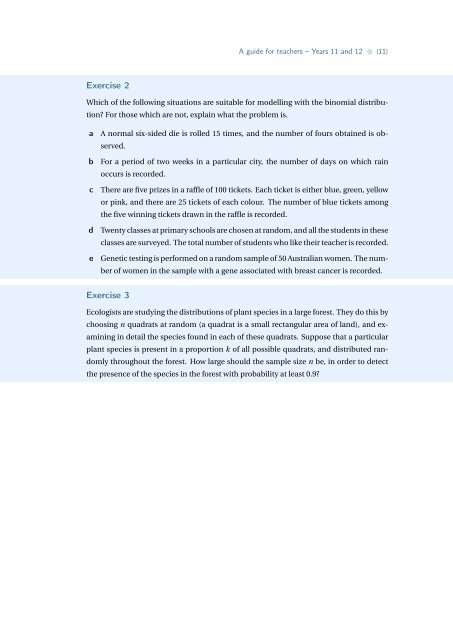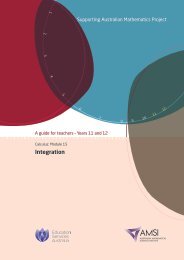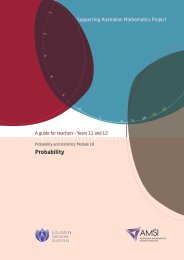Binomial distribution - the Australian Mathematical Sciences Institute
Binomial distribution - the Australian Mathematical Sciences Institute
Binomial distribution - the Australian Mathematical Sciences Institute
You also want an ePaper? Increase the reach of your titles
YUMPU automatically turns print PDFs into web optimized ePapers that Google loves.
A guide for teachers – Years 11 and 12 • {11}<br />
Exercise 2<br />
Which of <strong>the</strong> following situations are suitable for modelling with <strong>the</strong> binomial <strong>distribution</strong><br />
For those which are not, explain what <strong>the</strong> problem is.<br />
a<br />
b<br />
c<br />
d<br />
e<br />
A normal six-sided die is rolled 15 times, and <strong>the</strong> number of fours obtained is observed.<br />
For a period of two weeks in a particular city, <strong>the</strong> number of days on which rain<br />
occurs is recorded.<br />
There are five prizes in a raffle of 100 tickets. Each ticket is ei<strong>the</strong>r blue, green, yellow<br />
or pink, and <strong>the</strong>re are 25 tickets of each colour. The number of blue tickets among<br />
<strong>the</strong> five winning tickets drawn in <strong>the</strong> raffle is recorded.<br />
Twenty classes at primary schools are chosen at random, and all <strong>the</strong> students in <strong>the</strong>se<br />
classes are surveyed. The total number of students who like <strong>the</strong>ir teacher is recorded.<br />
Genetic testing is performed on a random sample of 50 <strong>Australian</strong> women. The number<br />
of women in <strong>the</strong> sample with a gene associated with breast cancer is recorded.<br />
Exercise 3<br />
Ecologists are studying <strong>the</strong> <strong>distribution</strong>s of plant species in a large forest. They do this by<br />
choosing n quadrats at random (a quadrat is a small rectangular area of land), and examining<br />
in detail <strong>the</strong> species found in each of <strong>the</strong>se quadrats. Suppose that a particular<br />
plant species is present in a proportion k of all possible quadrats, and distributed randomly<br />
throughout <strong>the</strong> forest. How large should <strong>the</strong> sample size n be, in order to detect<br />
<strong>the</strong> presence of <strong>the</strong> species in <strong>the</strong> forest with probability at least 0.9

















